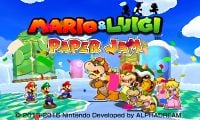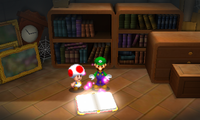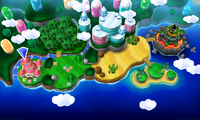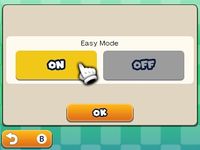






Whaddup, bros; ya boy TPG here. Today I'm going to explain just why Mario and Luigi: Paper Jam should not be on your holiday wishlist. If so, get that trash outta there! This game is frustratingly meagre at pretty much everything it has to offer; yes, it does make a few improvements, but overall it's a step down from its predecessors. Here's why.
Story
The story is a massive downgrade- I can just about stretch this plot out into a paragraph. You see, Luigi here is doing a thing until he bumps into a book, which just so happens to contain a bunch of Paper Mario things in it. I would say the entire world, but that obviously isn't the case 'cause all that comes flying out of the book are heaps of generic Sticker Star enemies, including about 250 generic, characterless toads. The paper baddies and the normal baddies team up to kidnap the Peaches and take over the world. Mario, Luigi, and another damn Mario then run around doing meaningless stuff, lose the Paper Mario book, defeat the Bowsers and get the book and the Peaches back. And Paper Luigi takes a nap on a beach, because they forgot what to do with him again and shoehorned him in at the last moment. 'Too difficult to control four characters'? Wasn't so bad last time they tried it.
You may be thinking, 'hey TPG there has to be more than that'. Right and wrong. The trio go to prison and bust out of there, and Peach's Castle is obliterated to pieces. But to be honest, that doesn't really matter. It would matter if they weren't just there to transition from one area to another. The prison is just there as a way to get Mario and co. to a beach area, and the destruction of the castle doesn't affect anything; it is still a fully functional area and it is barely touched upon apart from a minute of cutscenes. They advance to the next area regardless. And speaking of areas...
Setting
Woods, plains, snowy mountain, desert, beach, castle. That's it. Nothing interesting about this at all. In fact, a lot of these areas serve only as a transition to get to another area. You go through the plains and desert just to get to the castle, and you go to the woods just to get to the mountain. Nothing happens within these areas that makes me feel like I'm working towards any goal other than 'get to the castle'.
Five of these areas contain Toad Villages, where you can buy items, gear and cards (more on cards later). They're the same houses copied over every time, and after a few minutes you find out that these places have little to offer apart from transport to other villages, shops and Lakitu Centers. These places let you play minigames of varying entertainment value and host the Boss Rush and Attackathon. The Boss Rush never appeals to me anyway, but the Attackathon was one part I had a lot of fun with- you try out your Special Attacks but with added rules and events to not make it a total bore.
Whoops, I'm drifting. Anyway, the areas are generic, uninteresting and not very relevant. Next!
'Obligatory' Additions
You know what I mean. The new stuff they add that replace the previous new stuff: things like overworld moves or Bros. Attacks.
Mario and Luigi keep the tradition of having a Shell and Fire Flower as special attacks early on, but they also directly port ones from Dream Team such as the Dropchopper or the Bomb Derby. It does make up for it, however, by implementing Trio Attacks, special moves that only Paper Mario can activate and are given to him by Toads at various points throughout the game. As usual, they, along with the new Bros. Attacks, are fun to use and are just plain silly, although some of them don't feel as powerful as they should. For instance, the Balloon Blast is only really handy for taking out small groups of weak enemies, and does pathetic amounts of damage to bosses.
With Paper Mario on the team, they incorporated him into four things in the overworld: hammering, drilling, grabbing and flying. Hammering and drilling got upgraded; with the new Trio Hammer you can break large blocks and stun enemies allowing you to get the first strike. The Trio Drill now has charged speed boosts and automatically picks up Beans. These are pretty good additions, but the Drill takes a pretty long time to start.
A new move, the Trio Grab, allows the gang to... grab things and run around with them, and to grab onto posts to swing on over to them from wherever you were. The thing gets used loads to cross these frustratingly common gaps in paths, and it doesn't help that it takes a bit too long to play its animation before giving you control.
The Trio Glide makes Paper Mario spend about three seconds turning into an airplane and letting the plumbers glide through the air. Since you get it late into the game, you'd think it would be good for bypassing small obstacles like fences or streams, but nope; anything you can't walk through or jump over also has an invisible wall preventing you from flying over it. However, in open-air areas like Neo Bowser's Castle, the Trio Glide can be used to completely skip puzzles where invisible walls should have actually been placed. So, broken, badly implemented and a bore to boot up. 'Nuff said.
Additions that are pretty creative
My favorite addition to this game is the ability to dash; holding the X button makes the party jump, pause to build up speed, then start running at a comfortable pace that makes searching for collectables a lot less tedious. The X button also serves as a way to get every plumber to jump at the same time, but only at a low height. You can jump most steps and ledges with this, but blocks and some places require the use of the regular jumping buttons.
Your new playable character, Paper Mario, is controlled with Y, and he essentially functions as an extra bro. However, being from a different universe, he puts his own twist on things in battles. For instance, an individual Paper Mario is pretty weak, but he can clone himself up to six times (which can be increased to ten when levelling up). With more than one Paper Mario, you can land multiple powerful jumps or hammer multiple enemies depending on how many copies of Paper Mario you have. I found it a little overpowered later on in the game, and had to manually increase the 'real' bros' stats just to match the effectiveness of the paper juggernaut.
Replacing badges from the last two entries are battle cards, which are superior to badges without question. You create a deck of 10 cards that can be used to affect the battle: stat changes, revives, stuff like that. The better a card is, the more you have to pay for it in star points, which are earned through landing well-timed attacks. This system is great, but is held back with the amiibo support, chucking all of these potentially great cards at you that can only be used when you use an amiibo.
Battles in this game seem to focus more on battling loads of weak enemies at once rather than one or two strong enemies. This is true for most of the paper enemy variants. They appear in stacks of 5-10; individually they are easy game, but when together they take a lot longer to battle. They aren't difficult, they just take a while to kill off.
What I mentioned above was the alright stuff. Now onto the... less alright stuff.
Papercraft Battles
About six times in the game, you are 'treated' to this new mode. You control a giant cardboard model of a character and use it to ram into and destroy other models of enemies. Your attacks are fuelled with Toads that carry your papercraft about, and every attack scares off more Toads. However, there are dance mats strategically placed in the arenas that allow you to dance to attract more Toads to carry you forth. Every character craft has their own ability and each are specific to a boss.
You'd think that with a description like that it'd be a whole load of wacky fun. Well... nah. Your craft is incredibly sluggish, and the option of dashing makes you lose Toads, so a lot of the time you're inching without any real intensity, and I think every enemy is faster than you. Turning is also very slow and frustrating, and the camera is really unhelpful. The dance mats are a hit 'n miss; while they are simple and easy to use, they take ages to fill your Toad squad up and some enemies and bosses continue to attack you whilst you dance. In short, even though it functions, it's simply tedious.
Minigames
Minigames are used to carry out the bulk of interactions with the world and characters. Saving the many Paper Toads are all done through minigames, and any event during the plot is a minigame. You learn to recognize these delights when the screen fades to black and the obnoxious music plays. Some minigames are puzzles like when you have to catch Nabbit on tiles that disappear when you step on them, some are action-packed battle based ones, like defeating enemy hordes within five minutes, and then there's the hide and seeks with Paper Toads. The hide and seeks are... meh. You look for Paper Toads hidden within a set area, and when you do they give some randomly generated speech like, "I ran because I thought you were an enemy, but it turns out you're Mario!" and then into the inventory they go. About three-quarters of the minigames are focused on rescuing Paper Toads, and it is mandatory to complete all of them, with the game preventing you from progressing until you reach a certain amount of Paper Toads. In fact, to reach the final area you must collect all of 'em, but it turns out most of them were collected in excess. Waste of time.
The problem with these minigames isn't with the entertainment level- trust me, some of them were surprisingly fun- it's just that I felt like I was being interrupted whenever one of them started. Picture it like this: you're making a LEGO set- say, the Eiffel Tower- and you've placed all the bricks in the first bag. You attempt to open the second bag to finish your structure, but suddenly you have to play and win a game or two Jenga with some other blocks before being allowed to continue your LEGO. Sure, Jenga is great, but you wanted to play with your LEGO, not Jenga. ...Maybe it isn't the best example, but the point when you want to battle Wendy O. Koopa over some Fire Ore, you want an actual battle, not a game of dodge the bombs. That's something that happens, along with playing cannonball tennis with Morton Koopa Jr.
Mini points that didn't fit into a group
- The main portion of the game is not challenging. Some enemies have merciless attack patterns, but the game constantly throws healing items at you so it's not like taking a hit is detrimental to your battle. The puzzles and minigames are also pretty simple, even the Hard Modes they add are easily conquerable.
- Luigi is treated like dirt, even more than the last few games; if you like Luigi a lot, you'd best stay away from this one.
- There's this room in the Dip Dap Desert Dungeon where a path to a presumably cancelled room is blocked off by these big rocks.
- Grinding in this game is not fun. The novelty of finding new enemies with higher EXP drops in this game quickly dies after you battle 30 of 'em to try and reach their level.
- By the way, enemies have visible levels now. I don't know how it functions, but I think it serves as a guideline to help you grasp what level you should be on when fighting it. It's alright, but I was constantly under their level on my first playthrough and the meagre EXP you earn afterwards does not help you reach their levels.
- You are given your Special Attacks as you progress through the game, instead of earning them through collecting Attack Pieces like last time.
Presentation
If there's one thing I like about the series as a whole, it's the sprites. The level of detail that goes into each one is impressive at the bare minimum, and I love waiting at my turn in a battle to gaze at the enemy's animation cycle. This particular game actually features its final boss (Shiny RoboBowser) as a 3D model, which doesn't look half bad. Some of the animations are a bit stiff, but otherwise no complaints.
The music is enjoyable at most points, but not memorable. I enjoyed the battle theme along with the Gloomy Woods theme. Other tracks, such as the Koopalings' theme, are an earsore to listen too, but overall it's a typical soundtrack from Nintendo.
Now, the dialogue and humor. This game has an issue where it feels like every line of dialogue was written by the same person in the same tone. This really removes any personality any character has, and made me care even less about my goal than I already did. Some sentences were also really poorly written, particularly evident when Starlow, the objectively most terrible character in video game history, talks to you about how you should have 'initiative' to rescue the Paper Toads. The game made very few jokes outside of bashing Luigi and visual gags, but every now and then the writing did have me grinning.
One final thing about graphics: if you have played or seen Color Splash, you would know that every character has a stop-motion style to their movements, with no exception. In this game and Sticker Star, the paper characters constantly switch between having smooth, seamless movements and stop-motion, sometimes both at the same time. This. Is. Annoying. Seeing characters like Paper Bowser Jr. having these flowing animations next to Paper Bowser with his jerking-aboutness makes me kinda uncomfortable, it really does. What is it, Nintendo, smooth or stop-motion? Make your choice!
Rushed
Finally, The main problem with Mario and Luigi: Paper Jam is that it is rushed.
A shining example of this is the implementation of bosses. Lemmy, Iggy and Morton Koopa. These three Koopalings were given the luxury treatment when it came to bosses. However, you only battled them in the Koopaling battle rush just before the end, which is a damn shame because it was my favourite boss fight in the entire bloody series! It truly represents what these battles are supposed to be like; silly, wacky fun. These three dimwits have an 'all or nothing' gimmick where they use these insane massive attacks requiring the use of all the special dodging moves you learn in the game. Once you counterattack them, you have about three turns to deal as much damage as possible to all three of them before they start again. This battle is one of the few brilliant moments where you stop and think, 'Hey. I'm having fun with this.' But they also make major appearances in a lot of cutscenes, operating machines or plotting to set off a giant cannon. Sure, the dialogue falls flat, but they are much more developed than the other four. I felt like they had an actual role in the story.
However, the other four Koopalings, Larry, Wendy, Ludwig and Roy are given the cold shoulder. Their pre-endgame boss battles are crammed into random settings. While Roy and Wendy were already established as running the prison, which is where they are fought, Larry and Ludwig are found inside a pipe on the way to Bowser's Castle. You just walk in, and boom. Out come the boys in blue. No reason why they were inside a pipe. Just chillin' there. Doing what they want. In your way, unexplained. You fight them, and they go away, and back to normal.
Paper Petey Piranha is also like that. You make your way to Gloomy Woods, and you can already see the thing before the cutscene plays. You fight it without an introduction, and no one says a word once it's gone. Given that the game also tells you to fast-forward the introductory cutscene, you spend about 10 seconds not battling it. Charging Chuck Corps? They just appear and attack you out of nowhere, and again, you just move on without speaking once they're done bothering you. The time it took you to read that last sentence is probably equal to the time you spent caring about these bosses put together. Couldn't the developers just have spent some more time creating scenarios where the bosses made sense? Even adding dialogue from Starlow before and after would improve it. But I guess they didn't have the time to do any of that.
And therein lies the problem. A lot of this game's flaws aren't really deeply rooted in the system or mechanics, but rather because they were given too little time to properly polish said system. Maybe the deadline for scripting and character design was too close and AlphaDream had to resort to established, core characters that were easy to get on the cartridge. Maybe the time for testing was over too soon and they had to send in the controls despite their slow nature. Perhaps another 6-12 months could have meant a balanced Paper Mario, a fleshed out story and setting, and general refinement. AlphaDream are still the same as they were before, maybe a little more influenced by Miyamoto, but they are definitely capable of producing a great RPG. After all, they are the same guys that made Superstar Saga and Bowser's Inside Story.
So overall, this isn't an awful game, it's just... mediocre compared to its family. If you play it, yeah, you might enjoy it, but if you have a 3DS there are much better things to get for the holidays. Dream Team's good, definitely. But this game is just a step back. They played it safe with the characters and story and had too little time to perfect the new additions.
Well, cheers for reading, and see ya!
| The 'Shroom: Issue 117 | |
|---|---|
| Staff sections | Staff Notes • The 'Shroom Spotlight • End-of-the-Year Awards • Director Election |
| Features | Fake News • Fun Stuff • Palette Swap • Pipe Plaza • Critic Corner• Strategy Wing |
| Specials | Ultimate Music Battle • Paper Sham, Sour Jam |





